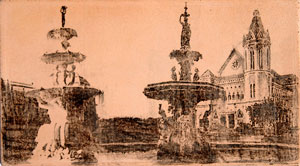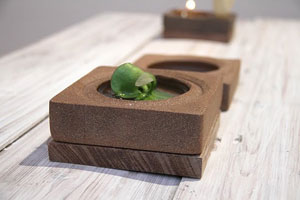A Cry for Our City
By Maheen Bashir | Art | Arts & Culture | Published 15 years ago
Pakistani art collectors are still acclimatising themselves to postmodern art, but Pakistan’s young artists have settled into this genre comfortably and are exploring contemporary themes. “Varied Impositions,” a collaborative display by Maliha Peracha, Sadia Salim and Sohail Abdullah, at the Koel Gallery last month, speaks volumes about our crumbling heritage and, more importantly, about the violence that is gripping Karachi.
Exploring the display, one is lulled into concentration by a melancholy instrumental playing in the background. It matches the mood of the exhibition, which is one of betrayal and insecurity, and leaves one with an eerie feeling of nostalgia and sadness.
Sadia Salim, in her ‘Untitled Series,’ uses everyday objects to express her concerns: she transfers onto ceramic plates, images of newspaper articles. On closer inspection, one can even spot the recent devastating blast at the JPMC hospital. The use of the colour red against the black-and-white text depicts the fear and bloodshed that has enveloped the lives of people living in a city riddled with bomb blasts and violence. The black ants scurrying across the surface of the cups may well represent the local populace, and the all-encompassing nature of the threat pervading the city. A skilled ceramist, Salim’s use of teacups may be a deliberate attempt on her part to tell us that violence is an intrinsic part of our daily lives, just like the cups we use — both are inextricably woven into the fabric of our lives. The exhibit also includes another set of plates to display images of black electricity poles. The accompanying bowls are in red and blue, breaking the monotony of the image. It seems that the artist, by using a dash of colour, is jerking her audiences out of their stupor, and into the harsh realities of everyday life.
In ‘Cityscape,’ Salim includes sculptures in terracotta, wood and stone which create an illusion of symmetry and proportion. The sculptures are carefully combined to relay opaque and cold cities.

Maliha Peracha
Maliha Peracha plays with the notion of perspectives and angles waiting to be discovered, capturing public apathy towards decaying historical landmarks in her work. Her exhibit includes photo transfers of buildings on small tablets of stone. Two landmark buildings are depicted having a conversation, and leaflets handed out at the gallery contain the text of the conversation. The buildings are impressing their anguish at being mistreated. Frere Hall, familiar to all Karachiites, complains of the security barriers blocking its participation in the rest of the world.
Peracha’s exhibit strikes an emotional chord, especially with those Karachiites, who reminisce about the good old days when the city was free of such barriers.

Sohail Abdullah
Sohail Abdullah, the third artist in the exhibition, usually works with the tangible although he has a minor in photography. His exhibits in boxes relate to the vast expanse of the sea, and the objects it has spilled into the world. A goat’s skull in ‘Relic Case I’ and a dog’s jawbone in ‘Relic Case II,’ may seem inconspicuous and irrelevant within a vast plethora of items, but encased in wooden boxes they acquire a certain meaning. Moving away from the boxes, Abdullah also creates exhibits using only natural materials like clay, seawater and teak. ‘Sapling box,’ one of the exhibits, shows a delicate sapling held in immutable clay. The artist, explaining his choice of the medium, says that fired clay is “at once imperishable and at the same time fragile” — the same dichotomy resonates with the sea, which is immense, yet vunerable.
Sohail Abdullah, Maliha Paracha and Sadia Salim’s work captures the spirit of Karachi as a coastal city and as a city rich in historical value.
Maheen Bashir Adamjee is an APNS award-winning journalist. She was an editorial assistant at Newsline from 2010-2011.


